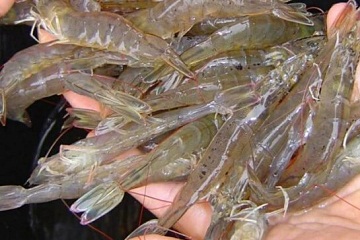The Research Team of IPB Investigated the Effects Seaweed Extracts for Vaname Shrimp Immunity

Aminatul Zahra, the student of Aquaculture Studies Program, of the School of Graduate Studies of Bogor Agricultural University (SPS IPB) implemented the research program to evaluate the effects of extract of seaweed Gracilaria verrucosa as an immunostimulant to fight White Spot on vaname shrimp Litopenaeus vannamei". This research was under the supervision of Dr. Ir. Sukenda and Dr. Dinamella Wahjuningrum.
One of the diseases occurrence in shrimp culture Litopenaeus vannamei is White Spot caused by White Spot Syndrome Virus (WSSV). White spot syndrome virus is highly virulent in shrimp farms and can spread quickly and – cause up to 100% mortality within 2-10 days. In Indonesia, WSSV appeared in West Java, Banten, Bali, Lampung, and South Sulawesi.
One the most effective effort to prevent the spread of WSSV, is the provision of immunostimulant. It also known as immunostimulators, are substances (drugs and nutrients) that stimulate the immune system by inducing activation or increasing activity of any of its components. One notable example is extract of seaweed G. verrucosa, it is safe and environmentally friendly immunostimulant. G.verrucosa contains some of the most important agar producer as containing polysaccharide compounds that usually contain galactose or galactan sulphate. Soome research revealed the active antibacterial fraction of G. verrucosa which is obtained from column chromatography indicated fractions containing antibacterial compounds. These polysaccharides have antiviral, anticoagulation, antitumor and immunomodulatory activity in mammals
The optimum dose of extract of seaweed G. Verrucosa in the feed of vaname shrimp is expected to stimulate the immune system of this shrimp. The bioactive compound G.verrucosa can be obtained by extraction. In the extraction process many factors affect the results, one of which is the type of solvent. Further study to find out the best solvent used in extracting bioactive compounds on G.verrucosa extraction process is really required.
The research consisted of three phases. First phase was testing the best type of solvent. The second phase was to study proper dose of G. verrucosa extract to improve immune system and vaname shrimp resistance to WSSV. The third step had been carried out to investigate the most effective and the appropriate duration for the provision of G.verrucosa extract in improving the production performance and immune response of vaname shrimp (L. vannamei) against WSSV disease.
The research had been implemented in August – October 2015, in Vicomas Laboratory (Cibinong), Laboratory of the Department of Aquaculture, Faculty of Fisheries and Marine Sciences of Bogor Agricultural University (FPIK IPB), and Research Center and Development of Bogor Freshwater Aquaculture. Vaname shrimp are fed at least three times a day. The observed parameters were total hemosit (THC), phagocytosis (AF) activity, hemositic differential (DHC), phenoloxidase (PO), respiratory burst (RB) activity, survival rate, daily growth rate (LPH), feed conversion ratio (FCR) , Nested PCR, histopathology, and clinical symptoms.
The research concluded that G. verrucosa extraction with ethyl acetate solvent produces active ingredient such as phenol, vanillin, phytol, ester, sulphate, and galactose. The optimum dosage for the provision of G. verrucosa extract was 4 grams per kilogram of feed significantly increased immune response and also vaname shrimp resistance to WSSV. The duration for two weeks (seven-day intervals) for a month provision of G. verrucosa extract was the best results for improving the production performance and immune system, as well as the resistance of vaname shrimp to WSSV. (Wied)



